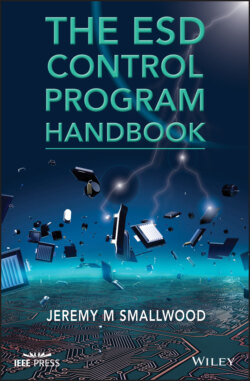Читать книгу The ESD Control Program Handbook - Jeremy M. Smallwood - Страница 77
2.8.4 Rate of Charge Neutralization
ОглавлениеEach ion that reaches a charged surface will add its charge to the surface. As this is usually the opposite polarity to the surface charge, the arriving ion will normally neutralize an equal and opposite polarity surface charge. The rate at which ions arrive at the surface depends on the electrostatic field strength, the concentration of ions in the air, and the mobility of the ions (Jonassen 2016b). This can be thought of as an ion current flow. Different air ions can have different mobility depending on the size, polarity, and charge of the ions.
As the charged surface neutralization process continues, surface voltages and field strength reduce, and the drift of ions to the surface reduces with the reducing field strength. The neutralization process continues ever more slowly until the electrostatic fields and thus forces on the ions are insufficient to attract further charge from the air.
If the surface voltage is monitored, the voltage is seen to reduce at a reducing quasi‐exponentially decaying rate. This is used in a charge plate monitor (CPM) instrument to measure the effectiveness of ionizers in neutralizing charges on surfaces. A typical voltage decay curve obtained is shown in Figure 2.25.
Figure 2.25 Electrostatic voltage on a CPM plate reducing during charge neutralization showing decay time and offset.
Charge neutralization by ionizers is typically quite a slow process and can take tens of seconds or longer, depending on the electrostatic field strength and ion density in the region surrounding the charged surface. This charge density, and the speed of charge neutralization, can be affected by many factors.
